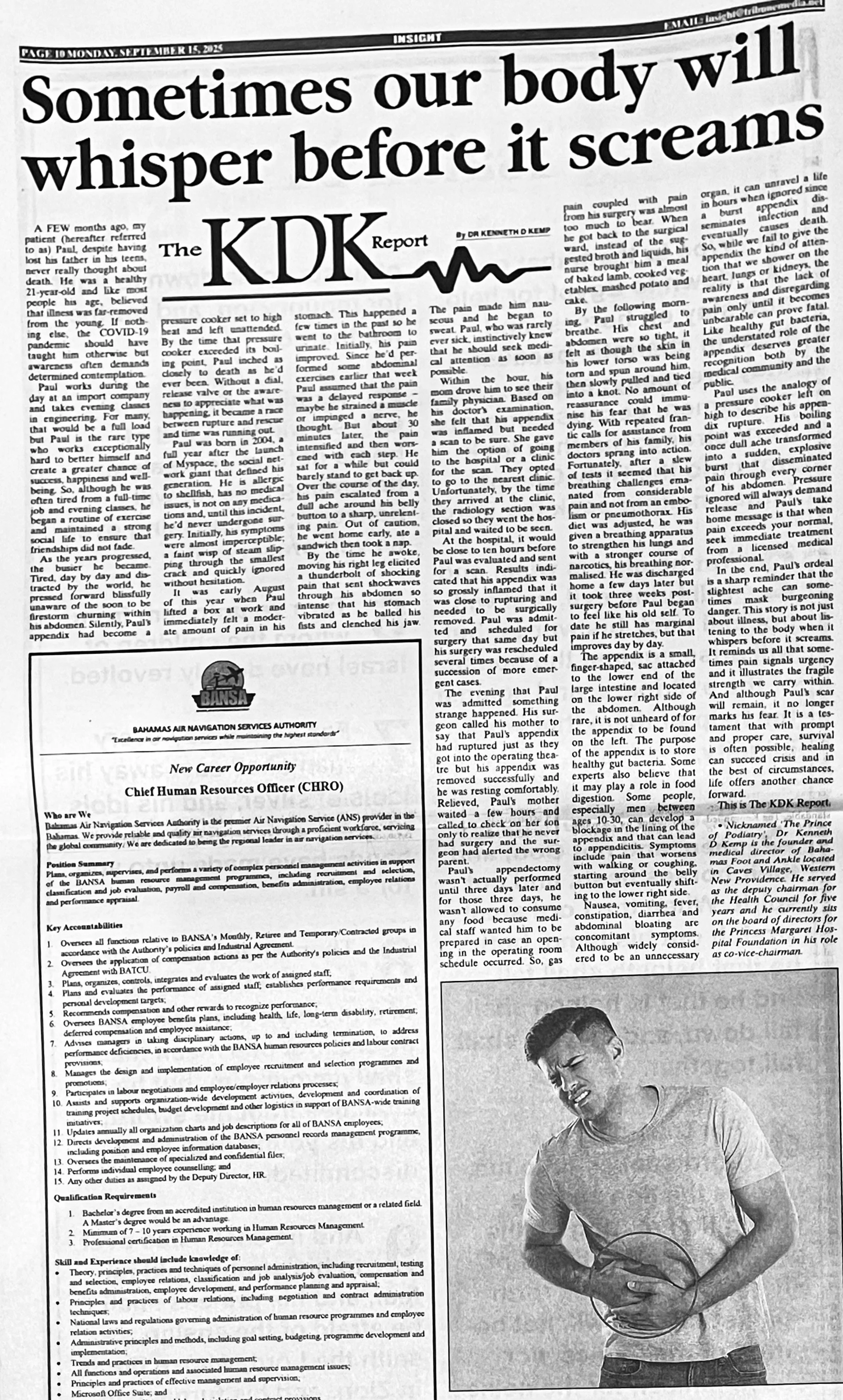Vol 122: Boiling point
A few months ago, my patient (hereafter referred to as) Paul, despite having lost his father in his teens, never really thought about death. He was a healthy 21-year-old and like most people his age, believed that illness was far-removed from the young. If nothing else, the Covid-19 pandemic should have taught him otherwise but awareness often demands determined contemplation.
Paul works during the day at an import company and takes evening classes in engineering. For many, that would be a full load but Paul is the rare type who works exceptionally hard to better himself and create a greater chance of success, happiness and well-being. So, although he was often tired from a full-time job and evening classes, he began a routine of exercise and maintained a strong social life to ensure that friendships did not fade.
As the years progressed, the busier he became. Tired, day by day and distracted by the world, he pressed forward blissfully unaware of the soon to be firestorm churning within his abdomen. Silently, Paul’s appendix had become a pressure cooker set to high heat and left unattended. By the time that pressure cooker exceeded its boiling point, Paul inched as closely to death as he’d ever been. Without a dial, release valve or the awareness to appreciate what was happening, it became a race between rupture and rescue and time was running out.
Paul was born in 2004, a full year after the launch of Myspace, the social network giant that defined his generation. He is allergic to shellfish, has no medical issues, is not on any medications and, until this incident, he’d never undergone surgery. Initially, his symptoms were almost imperceptible; a faint wisp of steam slipping through the smallest crack and quickly ignored without hesitation.
It was early August of this year when Paul lifted a box at work and immediately felt a moderate amount of pain in his stomach. This happened a few times in the past so he went to the bathroom to urinate. Initially, his pain improved. Since he’d performed some abdominal exercises earlier that week Paul assumed that the pain was a delayed response – maybe he strained a muscle or impinged a nerve, he thought. But about 30 minutes later, the pain intensified and then worsened with each step. He sat for a while but could barely stand to get back up. Over the course of the day, his pain escalated from a dull ache around his belly button to a sharp, unrelenting pain. Out of caution, he went home early, ate a sandwich then took a nap.
By the time he awoke, moving his right leg elicited a thunderbolt of shocking pain that sent shockwaves through his abdomen so intense that his stomach vibrated as he balled his fists and clenched his jaw. The pain made him nauseous and he began to sweat. Paul, who was rarely ever sick, instinctively knew that he should seek medical attention as soon as possible.
Within the hour, his mom drove him to see their family physician. Based on his doctor’s examination, she felt that his appendix was inflamed but needed a scan to be sure. She gave him the option of going to the hospital or a clinic for the scan. They opted to go to the nearest clinic. Unfortunately, by the time they arrived at the clinic, the radiology section was closed so they went the hospital and waited to be seen.
At the hospital, it would be close to ten hours before Paul was evaluated and sent for a scan. Results indicated that his appendix was so grossly inflamed that it was close to rupturing and needed to be surgically removed. Paul was admitted and scheduled for surgery that same day but his surgery was rescheduled several times because of a succession of more emergent cases.
The evening that Paul was admitted something strange happened. His surgeon called his mother to say that Paul’s appendix had ruptured just as they got into the operating theater but his appendix was removed successfully and he was resting comfortably. Relieved, Paul’s mother waited a few hours and called to check on her son only to realize that he never had surgery and the surgeon had alerted the wrong parent.
Paul’s appendectomy wasn’t actually performed until three days later and for those three days, he wasn’t allowed to consume any food because medical staff wanted him to be prepared in case an opening in the operating room schedule occurred. So, gas pain coupled with pain from his surgery was almost too much to bear. When he got back to the surgical ward, instead of the suggested broth and liquids, his nurse brought him a meal of baked lamb, cooked vegetables, mashed potato and cake.
By the following morning, Paul struggled to breathe. His chest and abdomen were so tight, it felt as though the skin in his lower torso was being torn and spun around him, then slowly pulled and tied into a knot. No amount of reassurance could immunize his fear that he was dying. With repeated frantic calls for assistance from members of his family, his doctors sprang into action. Fortunately, after a slew of tests it seemed that his breathing challenges emanated from considerable pain and not from an embolism or pneumothorax. His diet was adjusted, he was given a breathing apparatus to strengthen his lungs and with a stronger course of narcotics, his breathing normalized. He was discharged home a few days later but it took three weeks post-surgery before Paul began to feel like his old self. To date he still has marginal pain if he stretches, but that improves day by day.
The appendix is a small, finger-shaped, sac attached to the lower end of the large intestine and located on the lower right side of the abdomen. Although rare, it is not unheard of for the appendix to be found on the left. The purpose of the appendix is to store healthy gut bacteria. Some experts also believe that it may play a role in food digestion. Some people, especially men between ages 10-30, can develop a blockage in the lining of the appendix and that can lead to appendicitis. Symptoms include pain that worsens with walking or coughing, starting around the belly button but eventually shifting to the lower right side.
Nausea, vomiting, fever, constipation, diarrhea and abdominal bloating are concomitant symptoms. Although widely considered to be an unnecessary organ, it can unravel a life in hours when ignored since a burst appendix disseminates infection and eventually causes death. So, while we fail to give the appendix the kind of attention that we shower on the heart, lungs or kidneys, the reality is that the lack of awareness and disregarding pain only until it becomes unbearable can prove fatal. Like healthy gut bacteria, the understated role of the appendix deserves greater recognition both by the medical community and the public.
Paul uses the analogy of a pressure cooker left on high to describe his appendix rupture. His boiling point was exceeded and a once dull ache transformed into a sudden, explosive burst that disseminated pain through every corner of his abdomen. Pressure ignored will always demand release and Paul’s take home message is that when pain exceeds your normal, seek immediate treatment from a licensed medical professional.
In the end, Paul’s ordeal is a sharp reminder that the slightest ache can sometimes mask burgeoning danger. This story is not just about illness, but about listening to the body when it whispers before it screams. It reminds us all that sometimes pain signals urgency and it illustrates the fragile strength we carry within. And although Paul’s scar will remain, it no longer marks his fear. It is a testament that with prompt and proper care, survival is often possible, healing can succeed crisis and in the best of circumstances, life offers another chance forward.
This is The KDK Report.




